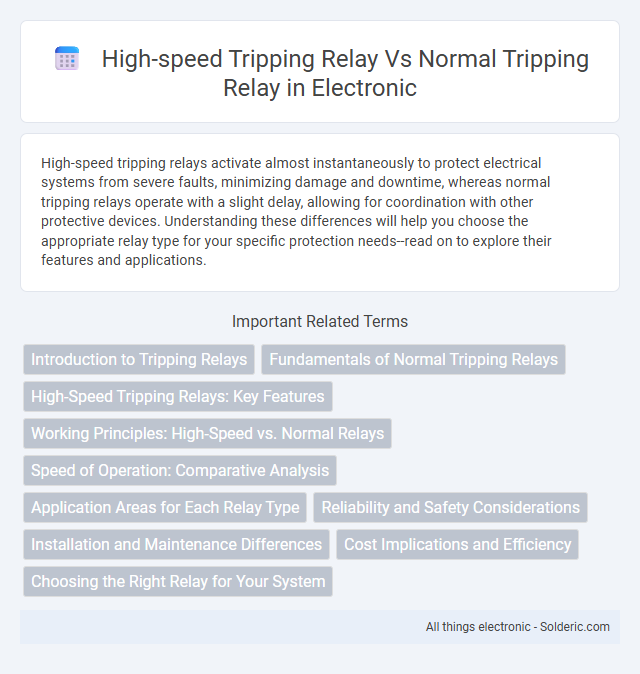High-speed tripping relays activate almost instantaneously to protect electrical systems from severe faults, minimizing damage and downtime, whereas normal tripping relays operate with a slight delay, allowing for coordination with other protective devices. Understanding these differences will help you choose the appropriate relay type for your specific protection needs--read on to explore their features and applications.
Comparison Table
| Feature | High-Speed Tripping Relay | Normal Tripping Relay |
|---|---|---|
| Trip Response Time | Microseconds to milliseconds | Milliseconds to seconds |
| Use Case | Critical protection in high-speed faults | General overload and fault protection |
| Accuracy | High accuracy for fast fault detection | Standard accuracy |
| Application | Power transformers, circuit breakers, HV systems | Motors, feeders, low voltage systems |
| Cost | Higher due to advanced technology | Lower cost |
| Complexity | More complex circuitry and setup | Simple design |
Introduction to Tripping Relays
Tripping relays are crucial components in electrical protection systems designed to disconnect power during fault conditions, preventing equipment damage and ensuring safety. High-speed tripping relays operate with significantly reduced response times, often in the range of milliseconds, enabling rapid disconnection in critical scenarios such as short circuits and transformer faults. Normal tripping relays have longer operating times suited for less severe faults, balancing protection sensitivity and system stability.
Fundamentals of Normal Tripping Relays
Normal tripping relays operate by detecting abnormal current or voltage conditions and initiate circuit interruption to protect electrical equipment from damage. These relays rely on preset time delays and current thresholds to differentiate between transient faults and sustained faults, ensuring coordination with other protection devices. The fundamental principle involves monitoring electrical parameters continuously and triggering a trip signal when deviations exceed safe operational limits.
High-Speed Tripping Relays: Key Features
High-speed tripping relays are designed to respond within milliseconds, ensuring rapid disconnection in critical fault conditions to protect electrical equipment and minimize damage. These relays feature advanced sensing technology, low operating time, and high reliability, making them essential for protecting high-voltage systems and industrial machinery. Normal tripping relays operate slower and are generally used for less critical applications where extreme speed is not required.
Working Principles: High-Speed vs. Normal Relays
High-speed tripping relays operate by detecting fault conditions through instantaneous or very low time-delay signals, enabling rapid disconnection of power to prevent equipment damage and ensure system stability. Normal tripping relays function based on predefined time delays and relay settings that allow temporary fault tolerances, coordinating with other protection devices for selective isolation. The key difference lies in the response time and sensitivity, where high-speed relays prioritize immediate fault clearance while normal relays balance speed with coordination to maintain system reliability.
Speed of Operation: Comparative Analysis
High-speed tripping relays operate within milliseconds, significantly faster than normal tripping relays which typically operate within seconds, ensuring rapid fault isolation to minimize equipment damage and system instability. The reduced response time of high-speed relays enhances protection in critical power systems by quickly detecting and interrupting fault currents. In industrial applications, this speed difference improves overall system reliability and reduces downtime compared to normal tripping relay responses.
Application Areas for Each Relay Type
High-speed tripping relays are primarily used in power systems where rapid fault clearance is essential to prevent equipment damage and ensure system stability, such as in high-voltage transmission lines and critical industrial processes. Normal tripping relays are suitable for less time-sensitive applications like distribution networks and general motor protection where slower response times do not compromise safety or performance. Your selection of relay type should align with the specific protection requirements and operational priorities of the electrical system.
Reliability and Safety Considerations
High-speed tripping relays provide enhanced reliability by detecting faults and initiating circuit disconnection within milliseconds, minimizing equipment damage and ensuring rapid fault isolation. Normal tripping relays, while effective, operate with longer response times, which can increase the risk of prolonged electrical faults and potential safety hazards. Your electrical protection system benefits significantly from high-speed relays by improving overall safety and reducing downtime during fault conditions.
Installation and Maintenance Differences
High-speed tripping relays require precise installation with calibrated settings to ensure rapid fault detection and response, minimizing system damage, whereas normal tripping relays have more straightforward installation procedures with standard settings. Maintenance of high-speed relays demands regular testing with specialized equipment to verify timing accuracy and sensitivity, while normal relays undergo less frequent and less complex inspections. The complexity and sensitivity of high-speed tripping relays result in higher maintenance costs and technical expertise compared to the more routine upkeep of normal tripping relays.
Cost Implications and Efficiency
High-speed tripping relays offer greater efficiency in fault detection and isolation, reducing downtime and potential equipment damage, which can lead to long-term cost savings despite their higher initial investment compared to normal tripping relays. Normal tripping relays, while less expensive upfront, may result in longer fault clearing times and increased operational risks, potentially increasing maintenance and repair costs over time. Selecting high-speed relays optimizes system reliability and minimizes costly outages, making them a cost-effective choice in critical power protection applications.
Choosing the Right Relay for Your System
High-speed tripping relays offer rapid response times ideal for protecting sensitive equipment from transient faults, reducing damage and downtime. Normal tripping relays operate with standard delays suitable for general fault conditions, ensuring system stability without unnecessary interruptions. Choosing the right relay for your system depends on balancing the need for swift fault isolation with overall network reliability and protection requirements.
high-speed tripping relay vs normal tripping relay Infographic

 solderic.com
solderic.com